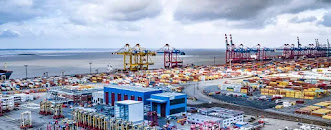ADVANTAGES & DISADVANTAGES OF PORT

The way ports operate today has changed dramatically as a result of technological advancements. Port performance has been improved thanks to automated systems, advanced navigation tools, remotely controlled cranes, and massive robotic cargo handlers. But there’s also the other side of the coin to consider.
With the increasing use of technology, the role of human labour is diminishing. Furthermore, possible cyber-attacks by individuals with malicious intent are a constant threat.
Let’s see some advantages & disadvantages of port automation.
ADVANTAGES
- Port Emissions Can Be Better Managed – Automation of mundane processes increases process performance, as we’ve seen before. Manual errors and delays are avoided, allowing the port to accommodate a greater number of ships. Increased productivity aids in maintaining the port pollution cap, ensuring compliance with environmental regulations.
- Time and Resource Savings – Operational efficiency ensures that each procedure is designed to consume the least amount of time possible. As a result, process automation saves a significant amount of time. According to statistics, automation can save ports up to 30% of the time spent on ship management, resulting in significant cost savings.
- Stabilization has been enhanced – Detectors and other electronic devices used in port operations planning ensure that processes are extremely stable. Automated processes are cleaner than traditional process flows because speed and safety are prioritized.
- Gains for long-terms – Automated systems do not need regular monitoring once they have been installed. The port is free of manual interference and can operate reliably for several years. The processes’ versatility means that any required improvements can be made and implemented quickly.
DISADVANTAGES
- LARGE CAPITAL EXPENDITURE – The cost of automation’s initial investment is incredibly high. These costs are out of reach for many ports, especially in developing and underdeveloped countries. As a result, a modified version of semi-automated ports is implemented, with technology serving as a backup for manual labour.
- ELIMINATION OF LABOUR UNIONS – The human aspect in the process is eliminated by automation. Many people would lose their jobs as a result of this. For obvious reasons, labour unions do not respond well to automated systems. The shift from employed workers to appointed supervisors can be challenging, and it can cause issues during automation implementation.
- THREATS TO CYBERSECURITY – For mega-ports with full or nearly complete automation, cybersecurity is becoming an increasing problem. Despite the use of reliable data sharing mechanisms, automated systems are vulnerable to malware attacks and data loss. A security breach can result in significant losses for the port, which is why port automation is an issue.
- EXORBITANT COSTS OF MAINTENANCE – To keep up with advancements in the technologies used, automated systems must be modified regularly. Ignoring updates can lead to serious security concerns, which is why all devices must be updated. This means that ports would have to pay for ongoing repairs.
After considering the benefits and drawbacks of port automation, it is clear that a healthy mix of human and technical input is needed in all processes. The power of technology combined with human intelligence will aid in the development of successful solutions for port automation.


